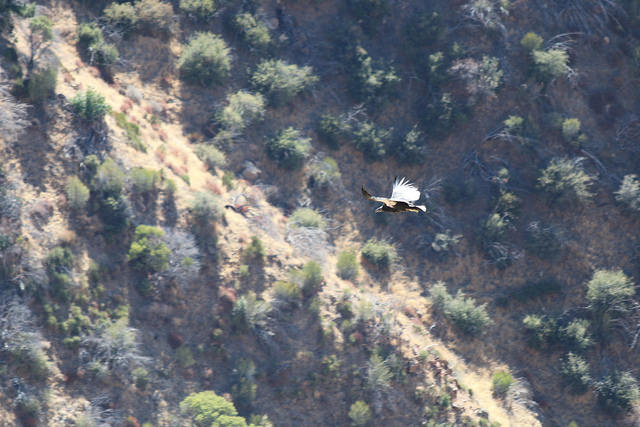First Baby Condor Fledges in Santa Barbara County

Capping a banner year for condor nesting — 12 egg-bearing nests in Southern California — is the successful fledge and flight of Santa Barbara County’s first baby condor in more than three decades. Endangered since the 1980s from the uninhibited use of pesticides, the California condor population has since come back in small increments. The new bird — condor number 933 — is the scion of condor 654, a 6-year-old female, and AC-4, a 38-year-old male that was hatched in the county in 1980.
The history of 654 is a short-course in the ongoing rescue of the California condor from extinction. Six-fifty-four hatched from an egg laid at the Peregrine Fund’s World Center for Birds of Prey in Boise, Idaho, said Joseph Brandt, a wildlife biologist with the U.S. Fish and Wildlife Service who can be seen scaling cliffs and dropping into condor nests in educational videos made about the condor rescue. Her egg was transferred to a wild nest in Southern California, and she was raised by foster parent birds. Right about the time AC-4 was released into the wild after 30 years in captivity, 654 reached breeding age, roughly 5 years old.
Biologists involved in the condor program stressed the importance of AC-4, who has fathered 30 chicks altogether. He was among the last 22 condors in California in 1982 that were captured in the effort to bring the great birds — their wingspan can reach almost 10 feet — back from the brink. Most are still alive in captivity, but of the four “originally wild” condors that have been released, AC-4 was the most recent and also the only one still living. He and 654 paired up last year — condors typically form long-term pair bonds, said Brandt — though their egg did not hatch last season. Of the 12 egg-nests identified in SoCal, six successfully produced baby birds. The Central Coast flock of condors hatched another four.
California condor habitat has been re-established in the mountains from Monterey/San Benito to Ventura/Kern counties, populated with about 178 of the big free-flying birds today. The number is increasing, said Brandt, as the wild nests continue to nurture fledglings and captive-bred condors are released. The effort to save the scavenging birds, which feed on carcasses, has involved multiple federal and state agencies, indigenous tribes, the Mexican government, and zoos and museums across the west, including the Santa Barbara Zoo and the Santa Barbara Museum of Natural History.
California’s historic ban on lead ammunition, to take full effect in July 2019, has been progressively removing lead from condor and raptor scavenging zones. The legislative effort to change public ammunition use is now met with a new human-caused danger: microtrash. For reasons yet unknown, condor parents pick up coin-sized trash, like bottle caps, nuts and bolts, and glass, and regurgitate them for their chicks. Some biologists speculate they resemble shell and bone fragments that are normally fed as a source of calcium, but the resulting digestive track interference can be fatal.



